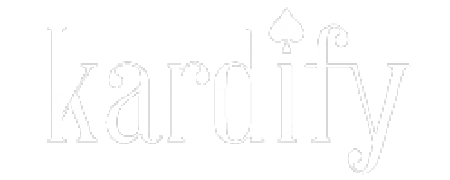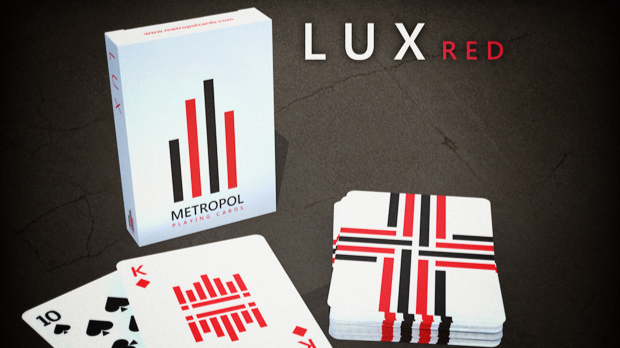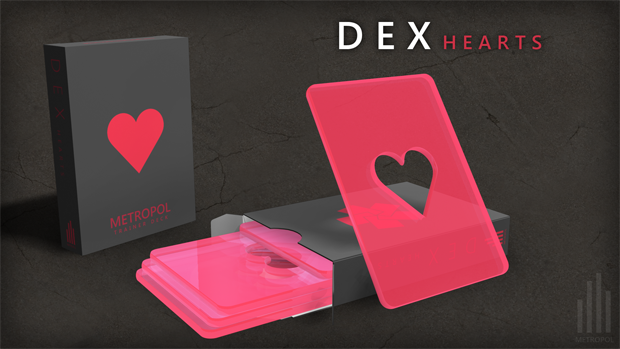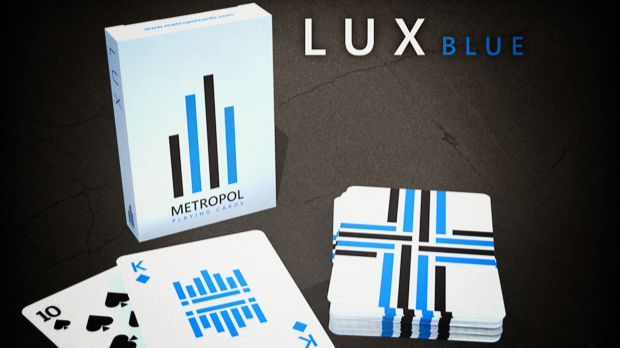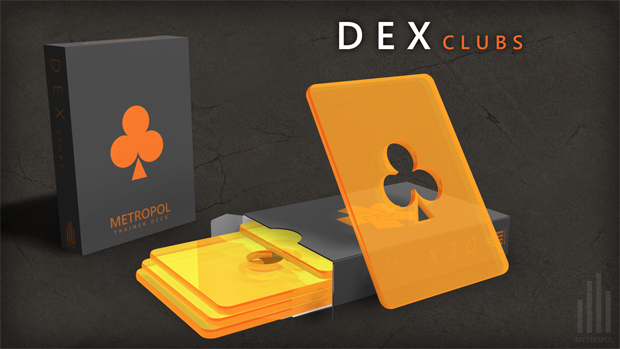Just launched on Kickstarter, the Metropol LUX Playing Cards is the companion deck to last years surprise hit- the Metropol NOX deck. Created by the talented Mike Lambert, the Metropol decks are inspired by current trends in digital design- clean, easy to read, and a unique take on the classic playing card design.
The bold deck design of the NOX has already proven popular with cardists. The unique 4-colour back design and colour suits enhances displays and card flourishes making fans, spreads, spins and cascades look absolutely stunning! The Metropol LUX is no different. It features 4 colour suits and is now printed by LPCC on their diamond finish card stock.
Having just completed the fulfilment of the NOX deck and preparing for the launch of the Metropol LUX, Mike took some time to chat with us about his design background, the inspiration behind Metropol LUX, the evolution of design of the deck and the take-away lesson from his first Kickstarter project.
Can you tell us about yourself and what is your design background?
I’ve been a 3D artist for over 15 years doing everything from movie FX, animated TV shows, product development, and video game artwork. Over the last few years I’ve started to branch out into video game design and programming. I’ve been a poker player for years and always liked playing card design but it was something I never considered possible for the average person to get into. Kickstarter and other crowd-funding platforms changed all that though. I got into playing card design because it’s pretty much the opposite of game programming. I enjoy both, but when I program at work all day it’s nice to have a creative outlet that’s completely different from my day job.
A little known fact about me, I’m colour-blind, red-green colour-blind to be specific. It’s hard to describe since I’ve always been colour-blind, but basically what that means is I sometimes don’t see red when it’s mixed with another colour. Because of my colour-blindness I have to approach my artwork differently that most people. I often rely on RGB values in Photoshop or Illustrator to help me figure out exactly what colour I need. This usually leads me to working with very vibrant, or very muted colour palettes. Another side effect of my colour-blindness is that I tend to focus more on contrast for separating different elements, rather than shades of colours. Whether or not that’s a good thing, I leave for the reader to decide. 😀
Can you describe the LUX deck and why you are passionate about it?
I’m excited to finally launch the LUX deck because it’s the other half of a set I designed over a year ago. The LUX deck is a companion to the NOX deck that shipped in March this year. NOX and LUX can be roughly translated as “dark” and “light” which describes the main colour of each deck. My inspiration behind the design was to create something bold but minimalist, which was quite the opposite of the intricately designed decks that were showing up on Kickstarter at the time. The initial design of the NOX deck got a lot of criticism, but despite the skeptics, it funded! To my surprise people were hungry for more of the bold simplicity that made NOX a hit. The passion people had for my work was really inspiring and encouraged me to help get LUX to see the light of day!
How much time did you spend working on the deck and can you briefly go through the design evolution of one of your unique card design?
I had originally designed NOX and LUX as a set in early 2013. LUX was actually the first of the two that I designed. After showing the design to a number of people it was obvious that NOX was the clear favourite and that LUX needed some work. The original design looks nothing like LUX today. It’s hard to say how much time exactly I spent getting LUX to where it is today. The current version is based off the original NOX deck which definitely saved a lot of time, but I really wanted LUX to be an evolution over the previous design, not just a re-colour.
This lead to an overhaul of the tuck case design, including getting rid of some of the strange USPCC restrictions for Canadian based designers. I also adjusted the placement of the pips and tweaked the colours a little. Though the difference with those last two items are probably so subtle only I’ll know the difference. 🙂 Even simple deck designs can take a long time to produce if you’re considering all aspects of the deck. All in all, I’ve probably been tweaking the LUX deck over the last couple months, whenever I have some spare time.
What was your most brilliant breakthrough when designing the deck?
I’d have to say designing the court cards was the turning point for this deck design. Looking back, I think I really struggled with the design of the NOX / LUX court cards in the beginning. The traditional court cards you see today are so iconic and so instantly recognizable. How do you replace that with something new and still get that same level of recognition? Although technically the design developed while working on NOX, the whole design language for the NOX / LUX series revolves around the court cards. Even the Metropol logo is based on the NOX/LUX court cards.
I was so excited about the design and layout of the number cards that I just jumped right into production and never really thought about the courts until everything else had been designed. I knew I didn’t want to do something as intricate as the traditional Bicycle courts. I just didn’t feel that level of detail would go well with the minimalism of everything else. I must have gone through 50 different design variations before landing on what you see today. I knew though, once I had that design that I was onto something, and I just ran with it. I know the courts have received mixed reviews but I’m really happy with how they turned out, and I know a lot of other people are too! They really brought the whole design of the deck together!
What are a few key elements and principles you incorporated into your project that you think future Kickstarter creators could benefit from knowing?
I’m sure most potential Kickstarters have heard this before but planning is key, and I’m not just talking about planning the design and production of your deck. Most designers should know every little detail necessary when it comes to producing their deck, but it’s everything else that can quickly become an issue if you’re not prepared.
When you get into manufacturing you start dealing with huge numbers most people never have to work with. With the USPCC, the minimum number of decks you can order is 2500. When was the last time you saw 2500 of anything? The cost for any individual element of a project like this is typically very cheap, but when you multiply it by 2500 the costs start to add up very quickly.
When it comes to manufacturing and shipping a lot of unexpected things can pop up. Most people know where to go if they want to buy 10 envelopes, but where do you go when you want to buy 2500? Even the customs labels for my international shipments became complicated. I had to go to 5 different post offices just to collect enough labels to stick on my packages because no single post office keeps that many in stock.
Physical space can become an issue as well. I learned that I can fit no more than 200 2-deck envelopes in the trunk of my car! I had to make several trips to the post office in order to ship everything. The final receipt was almost 10 ft long and well into the thousands of dollars! I shudder when I see people offering free worldwide shipping and undercutting their prices to attract backers to their project. I shudder because I know how much everything really costs, and I know they’re going to get into trouble financially, which in turn puts project the project at risk of not shipping and would result in a lot of disappointed backers.
A helpful exercise I do to make sure I’ve thought of everything is walk through the entire production from design to final delivery to your backers. Most people say that shipping your product is the worst, most stressful part of a Kickstarter project. It’s where the most can go wrong. For me, I actually enjoyed that part the most. It was really rewarding to see those packages go out the door, and what helped make that part so enjoyable was all the planning I had done beforehand.
What are your thoughts about the continuous strong growth of playing card projects on Kickstarter?
There’s definitely been a boom in playing card projects over the last few months. When I first started getting into this space in early 2013, there were only a couple projects getting launched each month. Almost every one of them got funded, including designs that people wouldn’t look twice at today. Though today I’m noticing a growing divide in the projects that are successful vs. the ones that aren’t. With more and more people getting into playing card design, there’s now more choice than ever. The market only has so many dollars to spend each month so that means the better projects will float to the top while less refined projects will sink. Designers are going to have to up their game when it comes to presentation, design, extra features etc, if they want to ensure their project gets funded. In the end, the continued growth is great for playing card buyers because of all the options that are becoming available. As the pool of designers grows though, the competition to get funded or even noticed will become more and more difficult. Innovation will become key, and that’s a challenge I look forward to!
Finally, what are your favourite playing card decks?
Although I don’t have too many decks in my collection, I definitely have a couple of favourites. At the moment I’d have to say my favourite deck is the one I most recently backed on Kickstarter, Steve Minty’s Muertos deck. From a design stand-point I love everything about it. I’m a big fan of the theme, the presentation, the colours, all very well done. I can’t wait until they start shipping! I also really like Roni Lagin’s Density deck that was funded on Kickstarter earlier this year. The colour scheme on the tuck and the intricate geometric details are look great!
Thanks for your time and honest insights, Mike. All the best! If you like what you’ve read here and want to support the Metropol LUX deck, you can find it on Kickstarter here.
The Metropol LUX deck is available in three editions: the Metropol classic, the Metropol Red and the Metropol Blue. Pledge starts from CAD$14 and there are multiple add-ons available such as dealer coin, uncut sheet and most notably the eye-catching trainer decks, DEX. I reckon this is a must have for cardists who wants to master their skill. There are also multiple rewards that will be unlocked once the project hits its set stretch goals!

